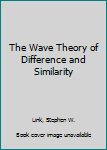The Wave Theory of Difference and Similarity
Two experimental procedures have prompted the empirical development of psychophysical models: those that measure response frequency, often referred to as response probability; and those that measure response time, sometimes referred to as reaction time. The history of psychophysics is filled with theories that predict one or the other of these two responses. Yet the persistent reappearance of empirical relationships between these two measures of performance makes clear the need for a theory that both predicts and relates these two measures. Most likely, both response measures are the result of a single process that generates empirical laws relating response time and response probability. It is this process -- its theory, description, and application -- that is the topic of The Wave Theory of Difference and Similarity . The author of this book has set out to provide a theoretical foundation for formulating new theories that systematize earlier results and to stimulate new concepts and introduce new tools for exploring mental phenomena and improving mental measurement.
Format:Hardcover
Language:English
ISBN:0805809260
ISBN13:9780805809268
Release Date:January 1992
Publisher:Psychology Press
Length:384 Pages
Weight:1.74 lbs.
Dimensions:1.2" x 6.0" x 9.4"
Customer Reviews
0 rating





